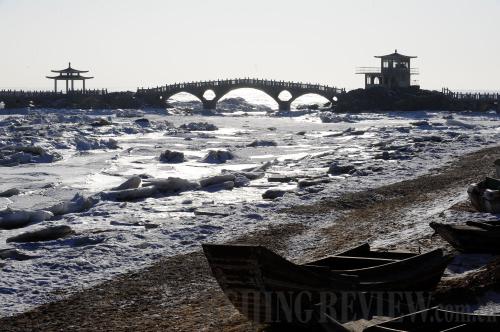|
 |
|
SEA ICE: Sea ice paralyzes the area near Xingcheng City in northeast China's Liaoning Province on January 22, 2010 (XINHUA) |
Sea ice in east China's coastal sea areas, covering Liaoning, Hebei and Shandong provinces as well as Tianjin Municipality, is the worst it's been in 40 years, the State Oceanic Administration (SOA) announced on its website this month.
Sea ice covered 45 percent of the Bohai Sea on January 22, compared with 40 percent just 10 days earlier, according to SOA. Xinhua reports said that as of January 17, sea ice covered an area of 19,200 square km, 7,584 square km and 4,224 square km, respectively, in Liaodong Bay, Bohai Bay and Laizhou Bay. In the Yellow Sea, an area of 4,320 square km is frozen.
SOA said the sea ice threatens transport, the aquatic breeding industry and petroleum exploration. Shandong has been hit hardest, with an initial estimated loss of nearly 2 billion yuan ($293 million). China's leading oil producer Sinopec told Xinhua that the company has closed six of its eight drilling rigs in the Shengli Offshore Oil Field because of the ice.
The economic disruption in Shandong has affected more than 95,000 people. As of January 20, more than 140,000 hectares of offshore aquatic farms and 500 docked fishing boats had been damaged, the National Marine Environmental Forecasting Center told Xinhua.
In Liaoning, residents on Juhua Island are besieged by the continuously expanding ice layer, which has affected 3,200 residents who now have insufficient living necessities, according to Xinhua.
On January 12, SOA issued an alert regarding the emerging sea ice disaster in Bohai Bay. The next day, Vice Premier Li Keqiang urged the oceanic watchdog to closely monitor the development of sea ice so as to prevent further damage. A special task force to minimize the damage from sea ice, headed by SOA Deputy Head Wang Hong, was established the same day.
The ice has frozen all six major ports in the coastal sea areas, hindering fuel transport, especially the transport of coal mined in north China to southern provinces. The transportation difficulties could cause a coal shortage in south China and leave residents without heating.
Sea ice also threatens the aquatic breeding industry, having killed over 50 percent of breeding seashells. SOA said that the death rate will rise as sea ice continues to expand, not only affecting industry workers but also resulting in a shortage of seafood products over the next year. In addition, hundred of fishing boats are frozen in clusters where fire would spread quickly.
Disaster-hit areas have worked out measures to cope with the ice disaster and ensure continued fishery production and safe marine shipping, according to Xinhua. All ocean and fishery departments are monitoring the sea 24 hours a day. Large-engine tugboats are escorting ships as they enter and exit ports.
Liaoning has set up rescue teams and breakers along key sea routes to break the ice so as to guarantee safe passage. Given the situation on Juhua Island, the city of Xingcheng in Liaoning Province has kept in contact with island residents and will break through the ice to send them food and daily necessities. The local government has also made preparations to send a helicopter in case of emergency.
Tianjin Port, 100 km southeast of Beijing, mainly serves passenger ships and coal cargo ships. It is using 10 ice breakers to constantly break up the ice. It has also strengthened coordination between various departments to ensure timely rescue services.
The Shandong Bureau of Maritime Affairs has sent Haixun 11, China's largest maritime patrol ship, to cruise the sea area near Qingdao and rescue any ship stranded by ice. Efforts have also been made to prevent traffic accidents and oil spills at sea. Areas covered with thick ice are closed to traffic.
Hebei Province has intensified disaster and emergency management measures to ensure smooth traffic in its three big ports—Qinhuangdao Port, Tangshan Port and Huanghua Port—where coal is transported from west China to south China.
From the beginning of the ice disaster, SOA has been monitoring the situation by means of satellite, radar, airplanes, ships and monitoring vehicles. It has set up a network consisting of eight satellites, two radar systems, two airplanes and 20 monitoring stations to report on the sea ice situation, according to the SOA website.
SOA said the current cold snap may continue to influence east China's coastal sea areas through the end of January and beginning of February, which could make the sea ice problem even worse. | 